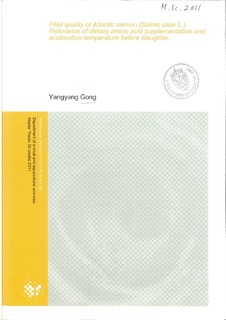| dc.description.abstract | The aim of the present study was to investigate the impact of dietary composition and acclimation temperature before slaughter on fillet quality development of farmed Atlantic salmon (Salmo salar L.). The fish were fed a commercial extruded diets or the same diet supplemented with arginine or glutamate for one year before they were harvested in May 2010 (average body weight was 3 kg). The fish were transferred from net pens in seawater (8℃) to small tanks on land with different seawater temperature (2, 8, 16℃) for 210 minutes before they were killed with a blow to the head. The rate of fillet contraction was analyzed during the first 24 hours after slaughtering, and fillet gaping, colour, fillet texture, muscle pH, cathepsins and ATP degradation products were analyzed at regular intervals during 12 days ice storage.
Acclimation temperatures had an overall significant effect on the fillet contraction from 3-12 hours storage with the highest contraction for the salmon acclimated at 16℃. The salmon fed the arginine diet had the significantly lowest contraction rate when the fish were kept at 8℃ before slaughtering, but no significant effect of dietary treatment were observed for salmon kept at 2 or 16℃. Neither acclimation temperatures nor the dietary treatment had any significant effect on the gaping and colour score. Within the 2℃ and 16℃ temperature treatment, a significantly firmer texture (higher Fb) was observed for the glutamate diet. 16℃ acclimation temperature resulted in a significantly lower pH both at 3 and 24 hours of storage, but not after 5 and 12 days of storage. The pH of the glutamate group acclimated to 2℃ had the highest muscle pH three and 24 hours post-mortem, and the reduction rate of the pH was slower for the arginine group kept at 8℃before slaughter as compared with the control group. Acclimation temperatures had an overall significant effect at 24 hours storage for the activity of cathepsin B (lowest at 2℃), and there was also found a significant effect at 0 hour for total activity of cathepsin B+L (highest at 8℃). The cathepsin B activity was lowest at 0 hour for salmon fed the arginine or glutamate diet at 2℃ acclimation temperature; whereas an inverse relationship was observed between the acclimation temperature and the cathepsin L activity at 24 hours for the salmon fed the arginine diet. High acclimation temperature accelerated ATP degradation after slaughtering, but the content of hypoxanthine (Hx) was lowest for salmon acclimated to 16℃ and highest for salmon acclimated to 2℃ after one week storage. It is concluded that the dietary supplementation of arginine and glutamate had positive effects on fillet contraction and texture, respectively. High acclimation temperature reduced the accumulation of hypoxanthine during storage, indicating prolonged freshness. | en_US |
